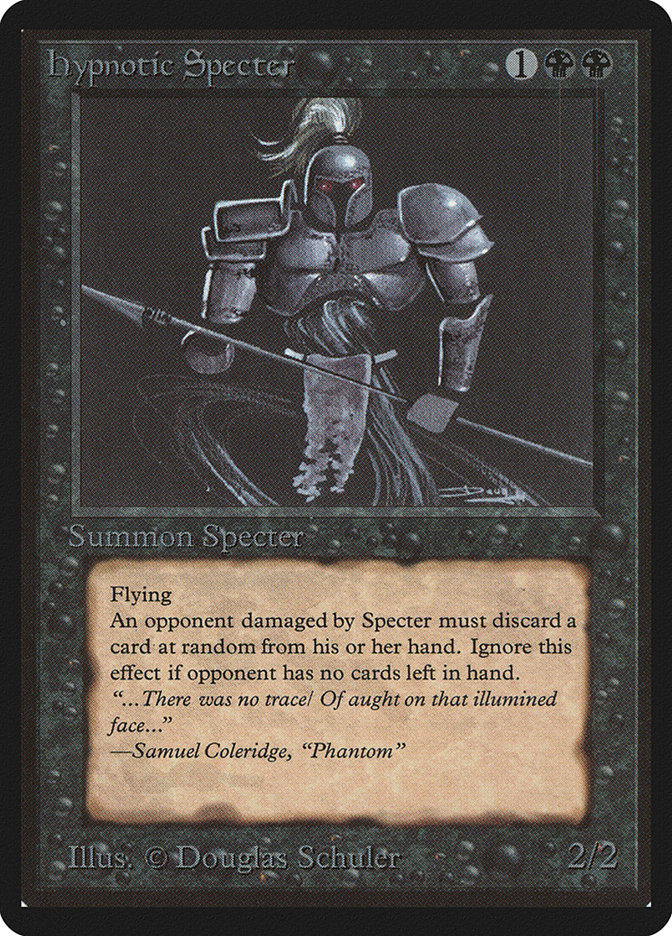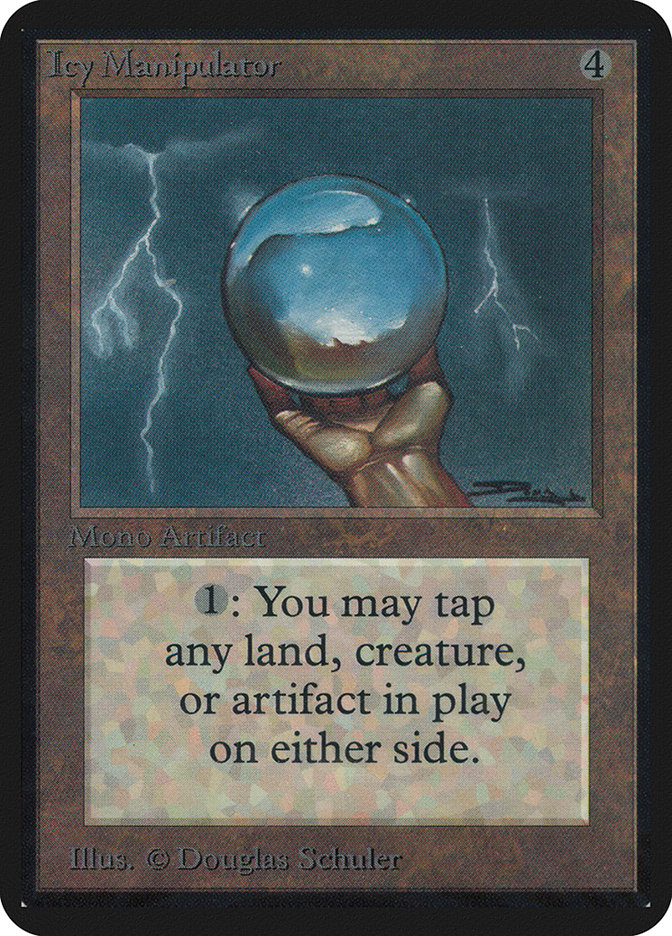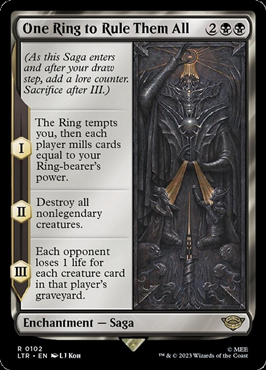Of all the new Magic cards spoiled from The Lord of the Rings: Tales of Middle-earth, the most eye-catching is The One Ring itself. Potent, mechanically unique and with a mind-bogglingly valuable serialized Elvish printing to be found… who wouldn’t be tempted by such a treasure?!
All I’m saying is if my cousin was as annoying as Deagol, I’d probably kill him for free, let alone for the sweet bonus jewelry. And while we know this is the only bit of legendary hand-bling in the set, we are getting a version of the elven, human and dwarven rings as alternate art sol rings.
But theme-deck brewers and aspiring Dark Lords need not worry! Magic’s history is already replete with potent and influential rings; more than enough to represent Tolkien’s full arsenal. Here are my personal recommendations to fill those 16 slots:
Jinxed Ring
We’ll open our list with what might actually be the strongest flavor fit for a Ring of Power: a magical item which you gift to a rival that then rapidly changes hands, bringing ill fate to all who touch it!
Cursed items can be hard to represent in Magic, since players tend to not add self-sabotaging cards to their deck for some reason. But Jinxed Ring has some legitimate uses.
For one, it can be a narrow but meaningful combo-hate card against decks like Eggs — ones that play few creatures but often abuse sacrifice lines featuring artifacts, enchantments or lands.
In a pinch, Jinxed Ring can also be a fine zero-mana sacrifice outlet for your own creatures. If you need to sacrifice more than one, you can just reactivate it a bunch of times holding priority before you allow any of the “opponent gains control” abilities to resolve.
Sisay’s Ring
Sisay’s Ring may not be as tempting or dynamic in its power as Jinxed Ring, but it is probably just a better card all-round. A playable, workhorse mana rock with some appropriately “fellowship”-centric flavor, this is a card you might only play to complete a deck building theme. But it’s definitely playable.
Moonring Mirror
I’ve been a fan of this “ring” ever since trading for it back in my very early days of Magic, and for years I feel like it hasn’t gotten its due as a casual Commander staple. Well, even The One Ring was overlooked for decades as one weird hobbit’s party trick.
Perhaps “artifact Thought Reflection for two less mana” can also make a sudden return to notoriety? Especially since more cards care about “cards being put into exile” nowadays…
Ring of Xathrid
Nowadays it’s more common for cards like this to be actual colored artifact spells, but I like that Ring of Xathrid is usable even outside of its “home” color.
All five rings in this M13 cycle are fairly decent, but the defensive ability makes Xathrid stand out. Black can really struggle to protect key creatures from removal compared to blue, white or green decks, so being able to apply (and reapply) a defensive shield like regenerate makes this Ring a genuinely handy tool.
Ringskipper
OK look, I promise all of the rest of the list features literal rings. But I had to give this little guy his due!
Clash is a very weird and potent combo mechanic. Because you can choose to leave the revealed card on top after clashing, you can easily “guarantee” infinite clash wins once you find an Eldazi Titan or similar big thing on top.
Ringskipper converts this situation into winning combos easier than most clash cards. So long as you have a sac outlet and some way to stay mana neutral (or better) on recasting it, you’re one Blood Artist away from free wins. Don’t skip over him!
Replicating Ring
Given that Tolkien’s own inspiration for “mythic sagas about dangerous magic rings” came from Nordic legend, having a card from Kaldheim as one of our Rings of Power seems very apropos.
Mechanically, I see Replicating Ring as about an ideal power level for three-drop mana rocks. It’s one of several mana rocks to specifically synergize with proliferate, and it’s obviously great for any deck that cares about snow mana. And even outside of those situations, it still has one of the best upsides among its peers.
Barbarian Ring
For being one of the earliest appearances of the now-familiar “utility land cycle” in a Magic set, Barbarian Ring and the other Threshold-lands have really held up well.
This ring is a perfect encapsulation of red’s “barbarian” aggro philosophy: sacrificing life and cards to obtain hyper-efficient conversion of mana to damage. And as was further proven by Fireblast before and Ramunap Ruins (much) later, “retroactively” converting used lands into damage spells at the end of a game is the zenith of red burn’s power.
Boxing Ring
Like a lot of New Capenna cards, this ring absolutely oozes flavor. I really wanted to put it higher on the list as a result, but there are also a lot of awkward conditions attached that make it difficult to utilize Boxing Ring outside of dedicated fight-themed decks.
You can’t activate the tap ability “mid-fight,” so your fighting creature has to survive the encounter for this to work. And if you’re not piggybacking off other more open-ended fight triggers… well, lining up the creatures you’re playing with targetable, beatable opposing creatures of the same mana value is easier said than done (besides maybe token creatures).
Ring of Evos Isle
As with Ring of Xathrid, I rate Ring of Evos Isle highly thanks to its dual offensive/defensive buffs. But in addition to hexproof slightly outperforming regenerate in most cases, blue decks are just a much more natural fit for a slow-to-impact equipment spell.
Ring of Evos Isle is very efficient in both mana and card terms, so the more you can slow the game down, the better it will be for you. A classic blue tempo deck will easily hold up the mana for its defensive activation while riding a single ring-bearer to victory.
Story Circle
What this entry may lack in explicit Ring-ness, it certainly makes up for in power. A last tribute to the powerful Circle of Protection cycles of early Magic, Story Circle’s flexible color targeting makes it much more reasonable to sleeve up outside of Constructed sideboard.
It retains the excellent mana efficiency of its predecessors, and you don’t need to target the source of the damage to stop it. You can also use this ability to negate incoming damage from your own cards — a classic way to exploit spells like Earthquake.
Oblivion Ring
Oblivion Ring might sneakily be among the more important cards ever printed when it comes to design space. Before Lorwyn, white got Pacifism effects for creatures and Disenchant for everything else. After Lorwyn, white’s power to flicker cards in and out of exile started to really come into its own, lending a very-much-needed source of flexible playmaking to that color.
As for the card itself, it’s much like The One Ring when stumbled upon by Bilbo: seemingly a straightforward and effective tool, but with a subtle, almost unlimited potential for great evil.
Wedding Ring
One of the most fundamental mythic tropes employed by Tolkien in his writings is the poisoned gift. The rulers of Middle-earth are corrupted by Sauron because they are too quick to embrace his generosity.
Just as his gifted rings turned noble Men into fell Nazgul, Wedding Ring instantly transforms a Commander free-for-all into a lopsided war of alliances, with one side empowered by a resource-generating feedback loop.
But if you don’t mind the politics it generates, Wedding Ring can be among the strongest cards in white’s arsenal. And for those willing to embrace victory through bigamy, flickering and cloning this Ring can completely unhinge the balance of a match.
Disciple of the Ring
The iconic and dominant reputation of Morphling during Magic’s early days has, over the years, sparked endless attempts to update the design. It’s hard to deny the conceptual appeal of a toolbox creature whose abilities promise to solve any situation when used just right.
But most modern imitators of Morphling flop because they try to provide those solutions exclusively by modifying their own stats. Modern Magic (especially multiplayer Commander) rarely hinges on the difference between a 2/4 and a 4/2.
Disciple of the Ring understands this, and its abilities have broader scope and higher ceiling than its competitors. Its additional cost prevents Disciple from becoming a combo engine, but it still enables other cards while defending you both in the red zone and on the stack.
Rings of Brighthearth
Our next Ring candidate has absolutely NO issues with generating infinites. It turns out that not being able to copy mana abilities is not that big of an obstacle when you can, for instance, copy an ability that untaps your mana source.
Are you someone who likes your combo pieces to also provide a lot of incidental utility? How about copying fetchland activations for efficient ramp? Copying planeswalker activations to double up on powerful down-tick effects? Copying extra turns to completely break the game?
Even in the high-powered Commander environment, Rings of Brighthearth stands out as an obvious stand-in for the mighty Rings of Power. Clearly Wizards of the Coast shares my opinion, because it is literally used as a proxy for the Three in Tales of Middle-earth Commander — something I didn’t even realize until after I’d made my list.
Sol Ring


Modern printings of this card love to make allusions to “the power of stars” or “the light of the sun,” but when you look at Mark Tedin’s iconic original illustration, there’s just no getting around what this “sole ring” was originally referencing. Commander players have been in the thrall of Sauron this entire time!
I could easily have placed Sol Ring at No. 1 and left it at that, but this list isn’t just about the most powerful rings in Magic — it’s about the most tempting, and ultimately perilous.
The actual in-game effects of Sol Ring are too mundane, and its presence too universal, to really capture that feeling of taboo. I feel as though the No. 1 Ring should represent limitless potential — the power to realize any desire, at a price.
Ring of Three Wishes
Bingo. Mark Winters knew exactly what was up when he created this sinister card art; if I covered up the M14 set symbol and told you this was literally depicting the temptation of Frodo, you’d have no trouble believing it.
Rings of Power, even outside of Tolkien’s legendarium, are always about the lure and danger of wish-granting. Ring of Three Wishes demands a much greater investment than Sol Ring, but if you’re in a position to spin up a ton of mana in one turn, its ability to immediately come down and Demonic Tutor makes converting into a game win very easy.
Our No. 1 ring only gets better from there: you can proliferate it, recur it, flicker it, clone it and otherwise do whatever it takes to multiply its already significant force. Heck, you can combine the No. 1 ring with the No. 3 ring(s) and cheaply duplicate the wishing ability! The synergies and flavor are simply too great to ignore – even when the cost is steep.
ONE LIST TO RANK THEM ALL



It may have taken a full thirty years before we got to see official Gandalf and Aragorn cards, but The Lord of the Rings influence on Magic runs as broad and deep as it does in all western fantasy games. Even where Magic intentionally jukes away from Middle-earth homage, it still frequently finds itself building on the same mythic foundations Tolkien used, and harmonizing with him in that way.
Some of the earliest popular deck building projects for Commander were Lord of the Rings themed lists, building off these strong thematic allusions to Tolkien’s lore. Adding official adaptations of The One Ring, the Nazgul, Sauron and the Witch-King just means that the creative potential for your canonically-complete twenty-ring Mordor deck has reached its zenith.

Tom’s fate was sealed in 7th grade when his friend lent him a pile of commons to play Magic. He quickly picked up Boros and Orzhov decks in Ravnica block and has remained a staunch white magician ever since. A fan of all Constructed formats, he enjoys studying the history of the tournament meta. He specializes in midrange decks, especially Death & Taxes and Martyr Proc. One day, he swears he will win an MCQ with Evershrike. Ask him how at @AWanderingBard, or watch him stream Magic at twitch.tv/TheWanderingBard.





















